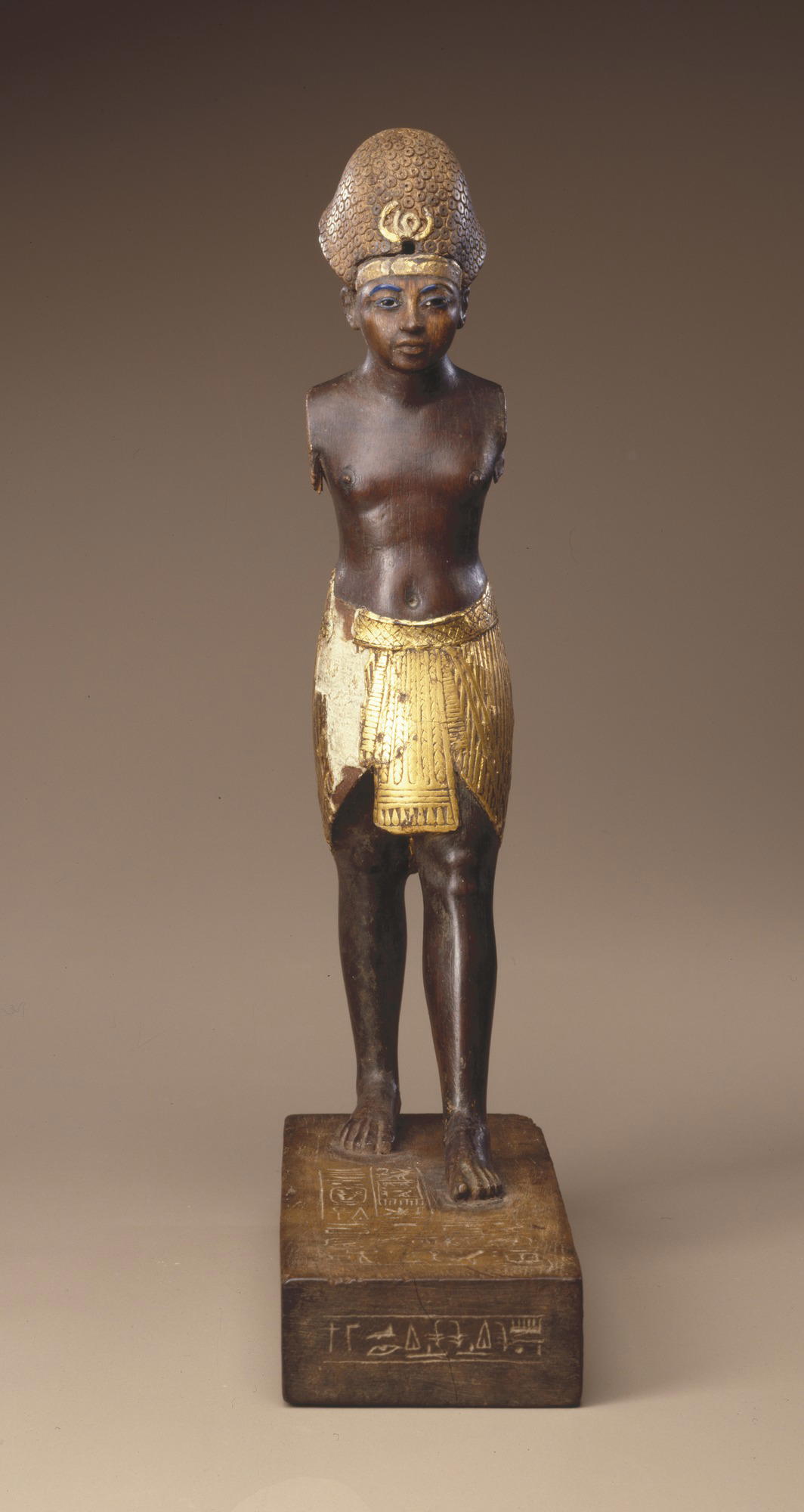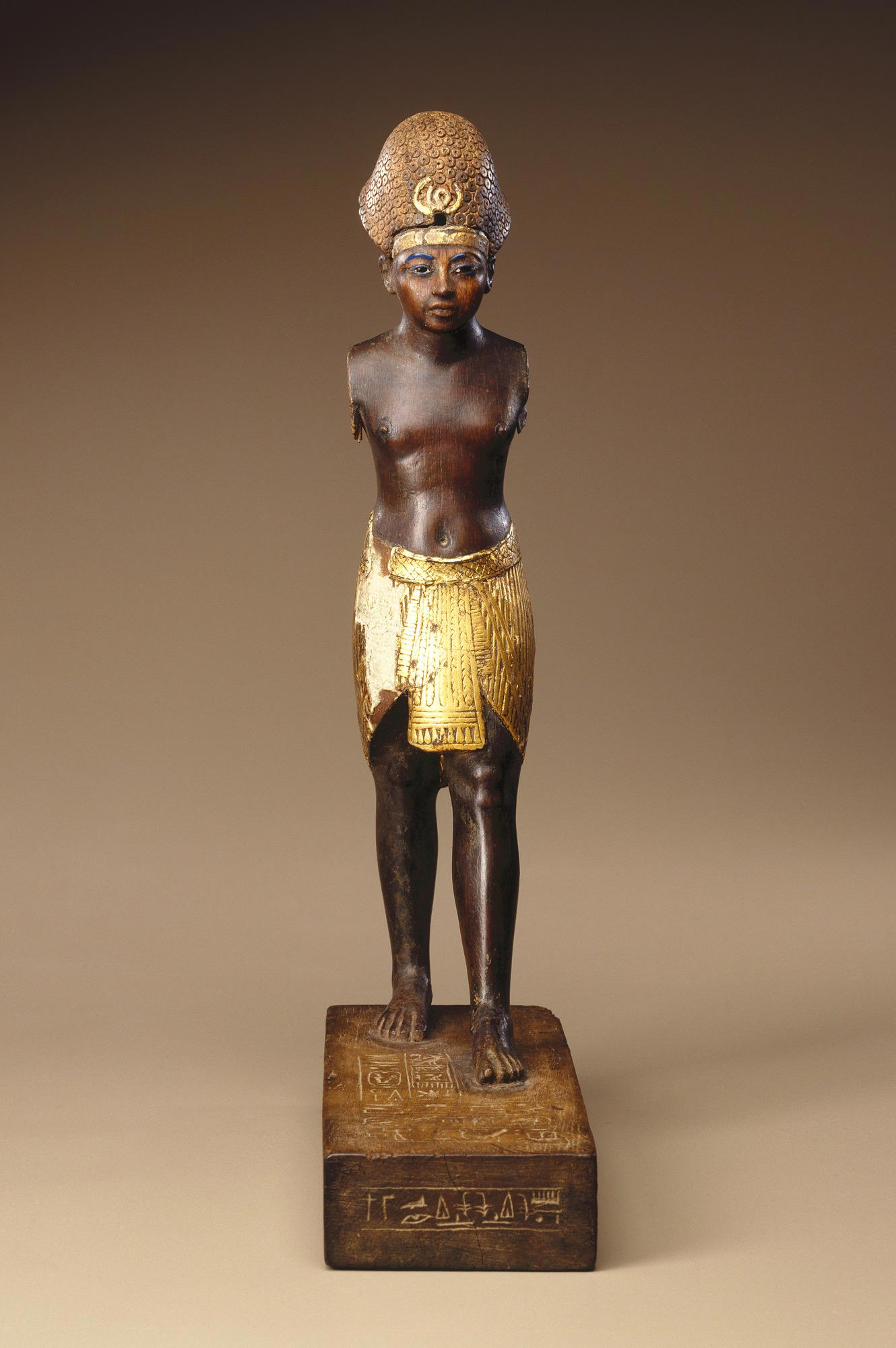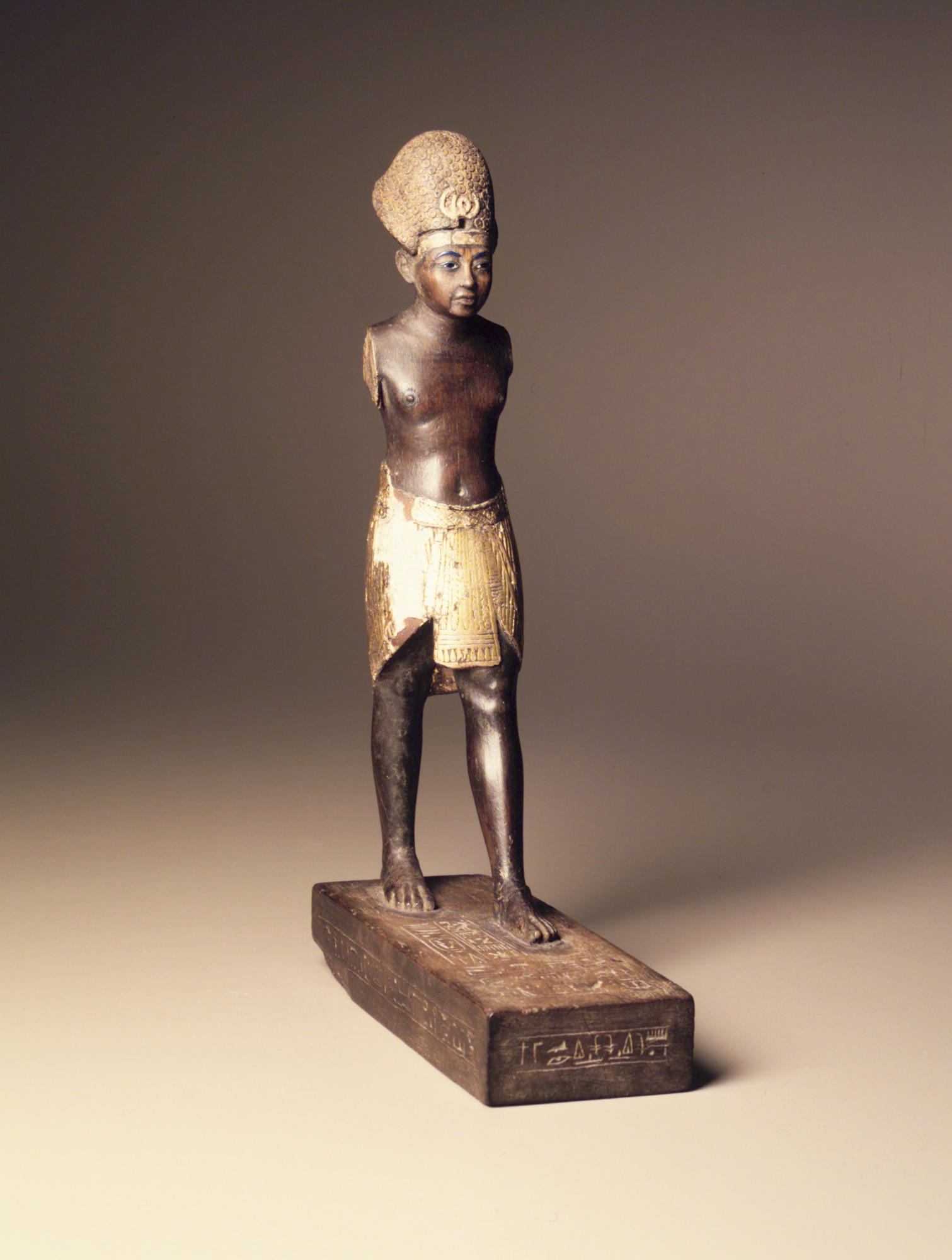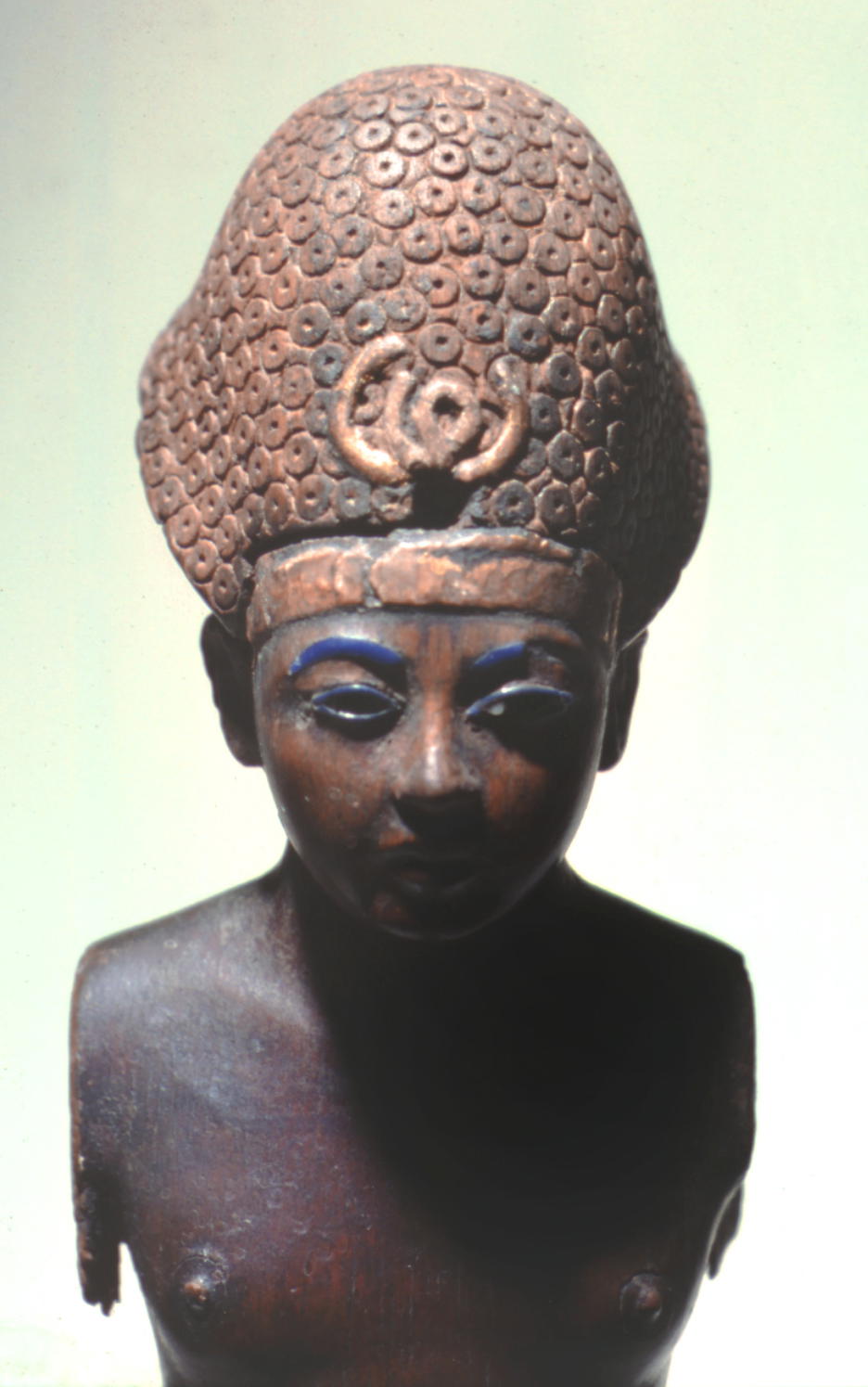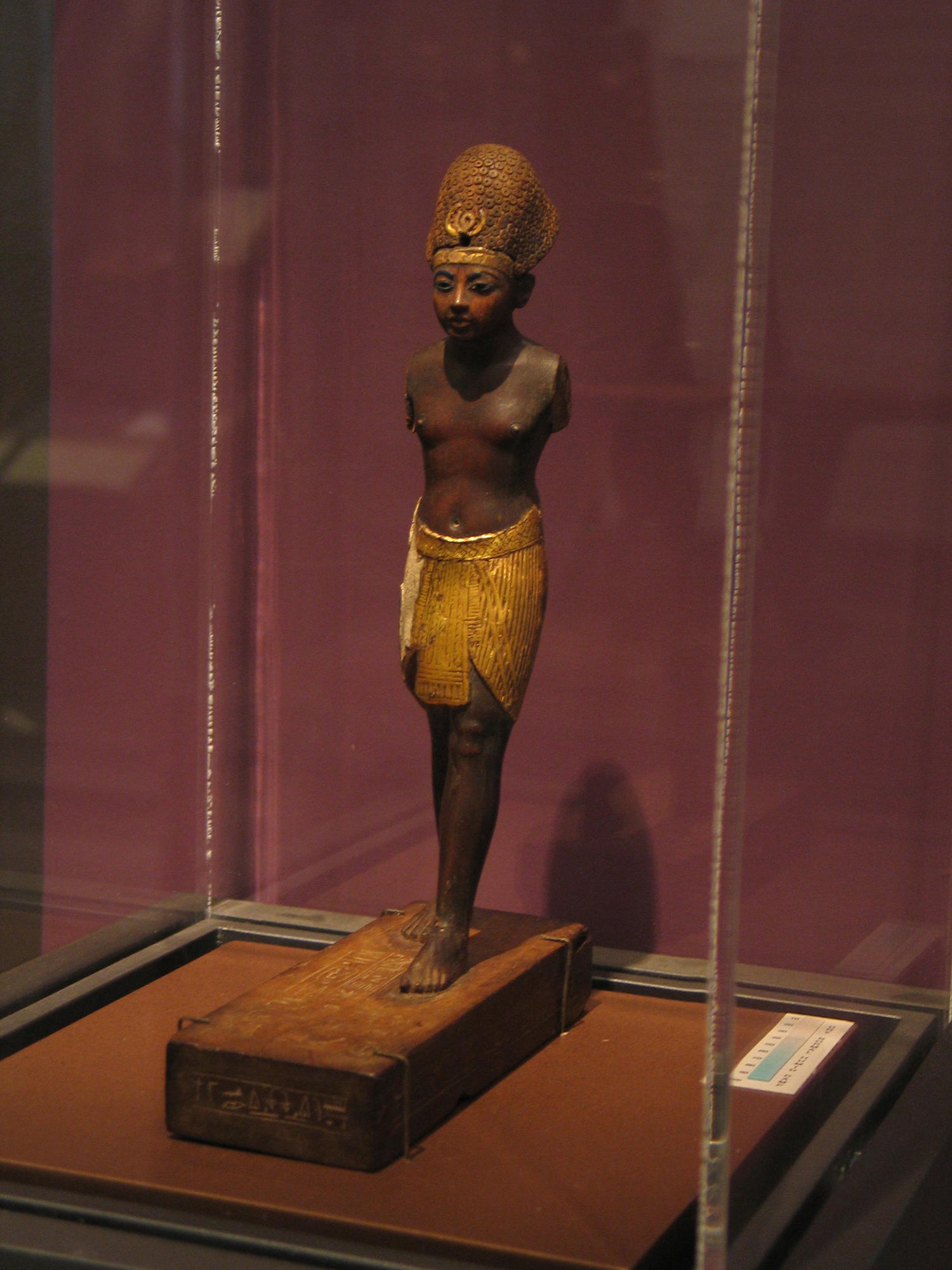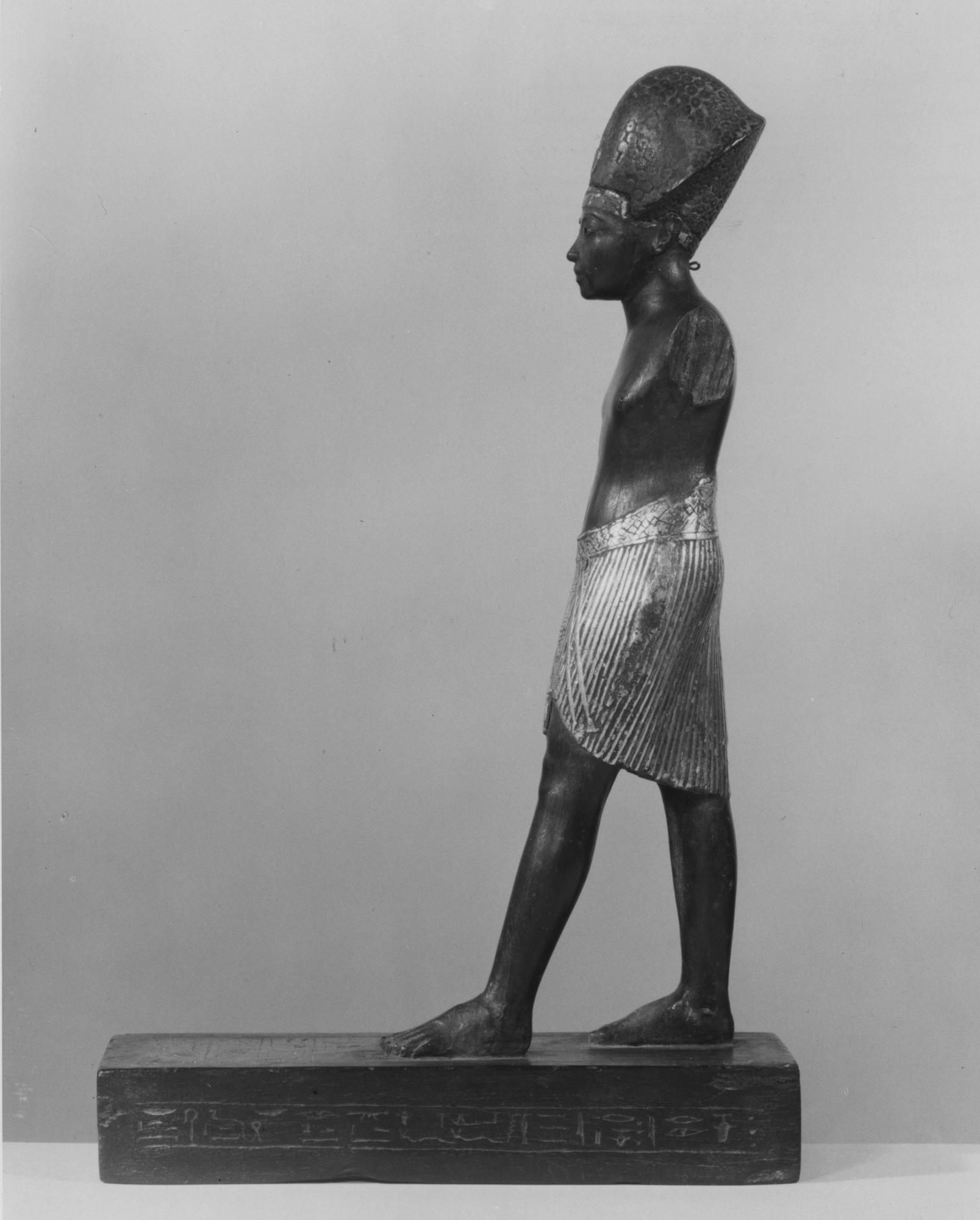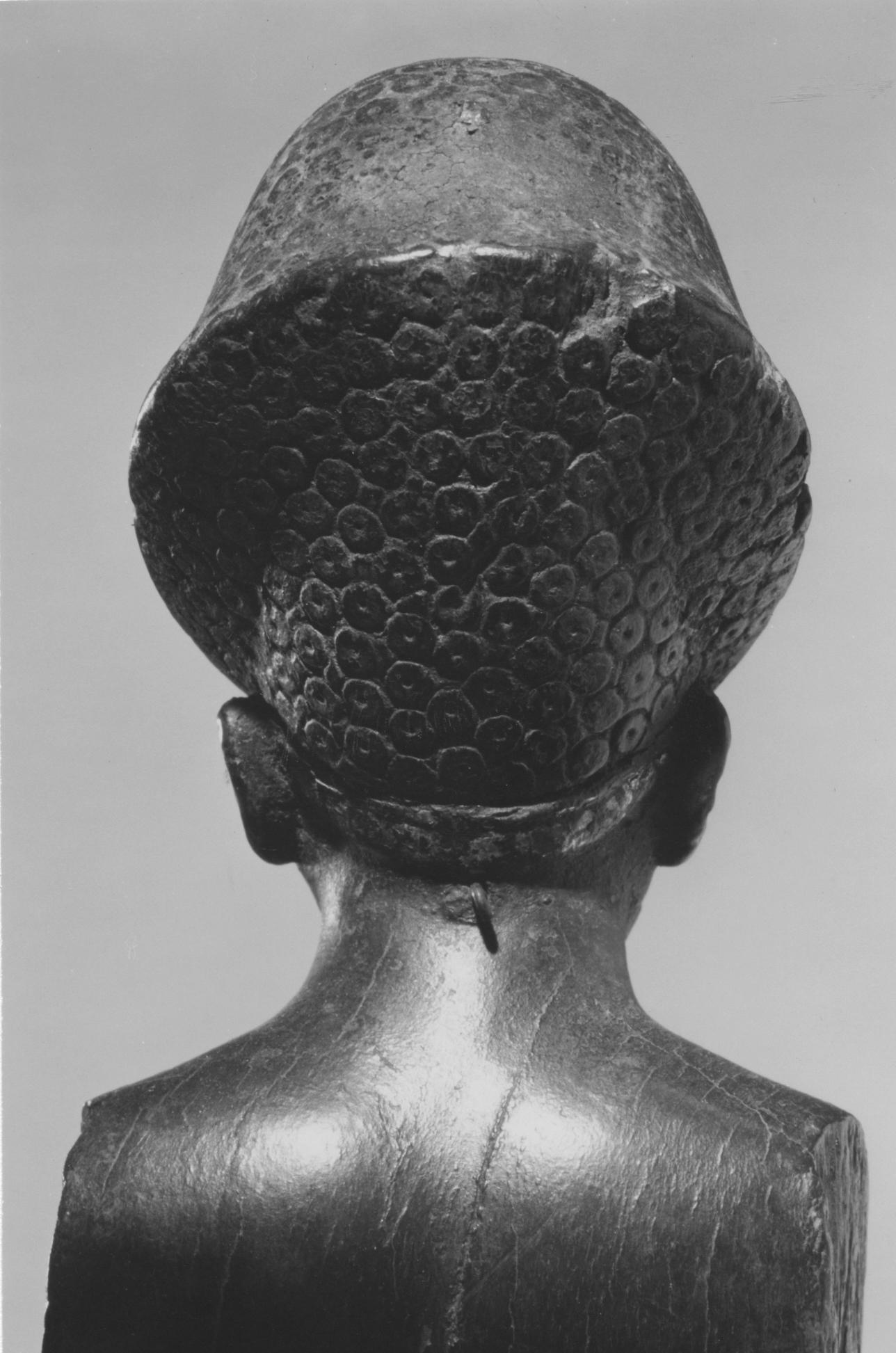1 of 27
About this Brooklyn Icon
The Brooklyn Museum is commemorating its 200th anniversary by spotlighting 200 standout objects in its encyclopedic collection.
Small but striking, this wooden statuette of Amunhotep III is a prime example of the artistic innovation that developed during this king’s long and prosperous reign. Amunhotep III’s face and figure are finely carved. His crown—known as the Blue Crown—and kilt are gilded, and his eyes and eyebrows are delicately inlaid with glass. The king’s rounded body might seem antithetical to stereotypically lean and strong depictions of pharaohs, but his form arguably reflects other types of divine power. His hips and belly, for example, represent fecundity and reference deities such as Hapy who were associated with fertility and the abundance of the annual Nile flood.
Amunhotep III was a prolific builder who constructed temples up and down the Nile. By the end of his 38 years of rule, he was himself worshiped as a divinity. Based on the inscription, this work was probably dedicated as a cult statue at the palace of Malqata at Thebes. It might have even been installed soon after Amunhotep III’s death, early in the reign of his son Amunhotep IV, also known as Akhenaten. The style of royal art would change even more during Akhenaten’s reign.
Object Label
The dynamics of permanence and change in Egyptian art are well reflected in this statuette of Amunhotep III. The form of the striding male figure dates back to as early as the Third Dynasty (circa 2675– 2625 <small>B.C.E.</small>). The Blue Crown did not appear until right before the Eighteenth Dynasty (circa 1539 <small>B.C.E.</small>), more than one thousand years later. The style was completely new: unlike most Egyptian kings, Amunhotep III allowed himself to be portrayed as an aging man with a noticeable paunch and sagging jowls.<br />
Caption
Amunhotep III, ca. 1390–1352 B.C.E.. Wood, gold leaf, glass, pigment, Total height: 10 3/8 in. (26.3 cm) Base: 6 5/16 x 1 1/16 x 2 3/8 in. (16 x 2.7 x 6 cm). Brooklyn Museum, Charles Edwin Wilbour Fund, 48.28. Creative Commons-BY (Photo: Brooklyn Museum, 48.28_front_PS4.jpg)
Tags
Title
Amunhotep III
Date
ca. 1390–1352 B.C.E.
Dynasty
late Dynasty 18
Period
New Kingdom
Geography
Possible place collected: Thebes, Egypt
Medium
Wood, gold leaf, glass, pigment
Classification
Dimensions
Total height: 10 3/8 in. (26.3 cm) Base: 6 5/16 x 1 1/16 x 2 3/8 in. (16 x 2.7 x 6 cm)
Credit Line
Charles Edwin Wilbour Fund
Accession Number
48.28
Rights
Creative Commons-BY
You may download and use Brooklyn Museum images of this three-dimensional work in accordance with a Creative Commons license. Fair use, as understood under the United States Copyright Act, may also apply. Please include caption information from this page and credit the Brooklyn Museum. If you need a high resolution file, please fill out our online application form (charges apply). For further information about copyright, we recommend resources at the United States Library of Congress, Cornell University, Copyright and Cultural Institutions: Guidelines for U.S. Libraries, Archives, and Museums, and Copyright Watch. For more information about the Museum's rights project, including how rights types are assigned, please see our blog posts on copyright. If you have any information regarding this work and rights to it, please contact copyright@brooklynmuseum.org.
Frequent Art Questions
Is it unusual for gilding on a Dynasty 18 wood figure to be so well preserved? If so, how did this figure get so lucky? Did someone important own it? Was the wood exceptional?
 Gilding like this was probably typical in ancient times. We are not certain what the dark wood is, but it might be ebony. In that case (if it is Ebony), it was imported from the east coast of Africa near Eritrea and would have been quite valuable. Both gold and ebony were used on only the most expensive objects for the highest class patrons.We actually do not know much about where this statue came from. We acquired it from a dealer in 1948. At that time, it was rare for dealers to record contextual information and pass it on to museums. The relative lack of damage suggests it was in an undisturbed place from antiquity until it was collected by the dealer. Chances are it was only collected in relatively recent times (1940s) when the object’s value as an antiquity was more valuable than the gold. Otherwise, the discoverer would have scraped the gold off of it. This state of preservation is very unusual.
Gilding like this was probably typical in ancient times. We are not certain what the dark wood is, but it might be ebony. In that case (if it is Ebony), it was imported from the east coast of Africa near Eritrea and would have been quite valuable. Both gold and ebony were used on only the most expensive objects for the highest class patrons.We actually do not know much about where this statue came from. We acquired it from a dealer in 1948. At that time, it was rare for dealers to record contextual information and pass it on to museums. The relative lack of damage suggests it was in an undisturbed place from antiquity until it was collected by the dealer. Chances are it was only collected in relatively recent times (1940s) when the object’s value as an antiquity was more valuable than the gold. Otherwise, the discoverer would have scraped the gold off of it. This state of preservation is very unusual.This is beautiful
 That is a New Kingdom sculpture of the king Amunhotep III. It is special because it is made of wood. Generally speaking wood was pretty expensive and rare. Given Egypt's climate most wood was imported. Wood rarely survives from antiquity, though we have some from Ancient Egypt thanks, again, to the climate.
That is a New Kingdom sculpture of the king Amunhotep III. It is special because it is made of wood. Generally speaking wood was pretty expensive and rare. Given Egypt's climate most wood was imported. Wood rarely survives from antiquity, though we have some from Ancient Egypt thanks, again, to the climate.Is there a particular reason why this object was used for the signage of the Egyptian Galleries?
 This image of Amunhotep III is an excellent example of Egyptian art and showcases how style and depictions have changed over time, which counters the idea that ancient Egyptian art stayed the same throughout time. It represents our collection well: have many very special pieces and many from the reign of Amunhotep III, a time of prolific art-making.
This image of Amunhotep III is an excellent example of Egyptian art and showcases how style and depictions have changed over time, which counters the idea that ancient Egyptian art stayed the same throughout time. It represents our collection well: have many very special pieces and many from the reign of Amunhotep III, a time of prolific art-making.Do you know what's written on it?
 The inscription on the top of the base, by his feet, talks about a festival that occurred during Amunhotep III's reign as well as some of his ceremonial names. The inscriptions on the side of the base appeals to the gods Amun-Re and Osiris, important deities in ancient Egyptian religious life.The festival, called the Sed festival, was a celebration of the king's long reign and a ritual of renewal. Through the festival, the king was symbolically reborn to ensure his continued reign.
The inscription on the top of the base, by his feet, talks about a festival that occurred during Amunhotep III's reign as well as some of his ceremonial names. The inscriptions on the side of the base appeals to the gods Amun-Re and Osiris, important deities in ancient Egyptian religious life.The festival, called the Sed festival, was a celebration of the king's long reign and a ritual of renewal. Through the festival, the king was symbolically reborn to ensure his continued reign.Can you tell me about his crown?
 It's a specific royal crown known as a "Blue Crown" which first appeared in Egyptian art a few generations before Amunhotep III, here.The Blue Crown was associated with legitimacy to rule, royal renewal, and victory. A pretty powerful statement piece! The shape itself is based on a type of headdress that the king would wear into battle, it emphasized the military prowess of the pharaoh.
It's a specific royal crown known as a "Blue Crown" which first appeared in Egyptian art a few generations before Amunhotep III, here.The Blue Crown was associated with legitimacy to rule, royal renewal, and victory. A pretty powerful statement piece! The shape itself is based on a type of headdress that the king would wear into battle, it emphasized the military prowess of the pharaoh.Can you tell me about this?
 This is such an amazing statue of the pharaoh Amunhotep III. His reign was a time of peace and grandeur. It is made of wood and gold, which were both quite an expensive materials in ancient Egypt.The way his face is carved seems to lifelike, to me. This is an interesting depiction of a pharaoh because Amunhotep III is shown as an older man, not an idealized man at his prime (which is more common).
This is such an amazing statue of the pharaoh Amunhotep III. His reign was a time of peace and grandeur. It is made of wood and gold, which were both quite an expensive materials in ancient Egypt.The way his face is carved seems to lifelike, to me. This is an interesting depiction of a pharaoh because Amunhotep III is shown as an older man, not an idealized man at his prime (which is more common).What's this?
 This is such an amazing statue of the pharaoh Amunhotep III. His reign was a time of peace and grandeur. It is made of wood, which was quite an expensive material in ancient Egypt.Wood rarely survives from antiquity, though we have some from Ancient Egypt thanks to the climate, it's very dry.
This is such an amazing statue of the pharaoh Amunhotep III. His reign was a time of peace and grandeur. It is made of wood, which was quite an expensive material in ancient Egypt.Wood rarely survives from antiquity, though we have some from Ancient Egypt thanks to the climate, it's very dry.It doesn't seem very blue to me. Why is it called the blue crown?
The shape, above all, is what makes it that specific type of Egyptian headdress. In theory, the version the king actually may have worn would have been blue and it does appear blue in other works.Do you think that, at any point in time, there was a human who played with these doll-sized figures like a child would? like even in the first days to weeks of its creation? Ultimately, what was the purpose of artwork like these at the time?
 I do believe that children played with doll-like figures in ancient times, however they generally would have been simpler that this and almost certainly made from cheaper materials.This particular figurine served a commemorative purpose, almost like a souvenir. The inscription references Amunhotep III's (the king depicted) sed festival, which is like a jubilee.Because the king played significant role in the ancient Egyptian religion as well as politics an image like this could then serve as a private cult image in the home of its owner.Outstanding! Thank you for your assistance!
I do believe that children played with doll-like figures in ancient times, however they generally would have been simpler that this and almost certainly made from cheaper materials.This particular figurine served a commemorative purpose, almost like a souvenir. The inscription references Amunhotep III's (the king depicted) sed festival, which is like a jubilee.Because the king played significant role in the ancient Egyptian religion as well as politics an image like this could then serve as a private cult image in the home of its owner.Outstanding! Thank you for your assistance!What type of wood is this made of?
 The species of wood has not been determined for this object, but other, similar, works have been identified as ebony and yew.That’s interesting, thanks!
The species of wood has not been determined for this object, but other, similar, works have been identified as ebony and yew.That’s interesting, thanks!There are inscriptions on the platform that he is standing on. Any idea what it means? They seem to be birds and ducks.
 The inscription (which does include some bird-shaped signs) refers to "festivals in the house of rejoicing" which scholars have determined is another way of saying the "sed" festival a type of jubilee that Egyptian kings celebrated.Because of this inscription, that also describes the king as "possessor of food, rich in sustenance," scholars believe that this statuette was created for a "sed" festival of Amunhotep III and may have even functioned kind of like a party favor.
The inscription (which does include some bird-shaped signs) refers to "festivals in the house of rejoicing" which scholars have determined is another way of saying the "sed" festival a type of jubilee that Egyptian kings celebrated.Because of this inscription, that also describes the king as "possessor of food, rich in sustenance," scholars believe that this statuette was created for a "sed" festival of Amunhotep III and may have even functioned kind of like a party favor.Was he a pharaoh of some sort? I notice his elaborate kilt and headpiece.
 Yes! Amunhotep III was a king (or pharaoh) of Egypt during the 18th Dynasty in the New Kingdom period. There was a tremendous amount of art production during his reign. In fact, there are more statues known today of Amunhotep III than any other king!The headdress he is wearing here is known as the Blue Crown (even though it is shown here in gold). The shape is based on a military helmet and it first became popular in the 18th Dynasty.
Yes! Amunhotep III was a king (or pharaoh) of Egypt during the 18th Dynasty in the New Kingdom period. There was a tremendous amount of art production during his reign. In fact, there are more statues known today of Amunhotep III than any other king!The headdress he is wearing here is known as the Blue Crown (even though it is shown here in gold). The shape is based on a military helmet and it first became popular in the 18th Dynasty.I think I remember hearing that Egyptians were interested in the perseverance of youth or looking a traditional way when they made sculptures but this sculpture shows the king aging. Was he one of the first to break the chain of the ideal figure?
 Very observant! Amunhotep III was not the first to be depicted aging or with sagging skin in his face. The kings of the 12th Dynasty were known for being shown with folds in their cheeks.These styles of depiction came and went like fashion trends. Looking youthful could communicate strength and longevity, but looking older could also communicate things like wisdom.Thanks :)
Very observant! Amunhotep III was not the first to be depicted aging or with sagging skin in his face. The kings of the 12th Dynasty were known for being shown with folds in their cheeks.These styles of depiction came and went like fashion trends. Looking youthful could communicate strength and longevity, but looking older could also communicate things like wisdom.Thanks :)Do you know what material he is made out of?
 This statuette is made of wood. The gold is gold leaf. And the eyes and eyebrows are made of glass.
This statuette is made of wood. The gold is gold leaf. And the eyes and eyebrows are made of glass.Is he wearing dark eye makeup?
 His eyes are lined blue glass. The color is a reference to lapis lazuli. It may represent make-up, but it could also simply reference the ancient Egyptian belief that the gods had hair made of lapis lazuli, an incredibly valuable material at the time.
His eyes are lined blue glass. The color is a reference to lapis lazuli. It may represent make-up, but it could also simply reference the ancient Egyptian belief that the gods had hair made of lapis lazuli, an incredibly valuable material at the time.Tell me more.
 This small statue was made for a festival known as a "sed" which celebrated the pharaoh and a long rule. It was supposed to be celebrated every 30 years. This pharaoh, Amunhotep III, celebrated the "sed" festival three times in his 38-year reign, however.This object may have been a gift for an attendee of one of these festivals and later functioned as a cult image in a shrine to the king.
This small statue was made for a festival known as a "sed" which celebrated the pharaoh and a long rule. It was supposed to be celebrated every 30 years. This pharaoh, Amunhotep III, celebrated the "sed" festival three times in his 38-year reign, however.This object may have been a gift for an attendee of one of these festivals and later functioned as a cult image in a shrine to the king.Is he wearing a royal crown?
 He is! There were a few different types of royal crowns in ancient Egypt, this one is known as the "Blue" Crown. Even though it is not blue here, scholars still refer to it this way because the shape is based on blue military helmets and showed that the king was a strong warrior.
He is! There were a few different types of royal crowns in ancient Egypt, this one is known as the "Blue" Crown. Even though it is not blue here, scholars still refer to it this way because the shape is based on blue military helmets and showed that the king was a strong warrior.
Have information?
Have information about an artwork? Contact us at








